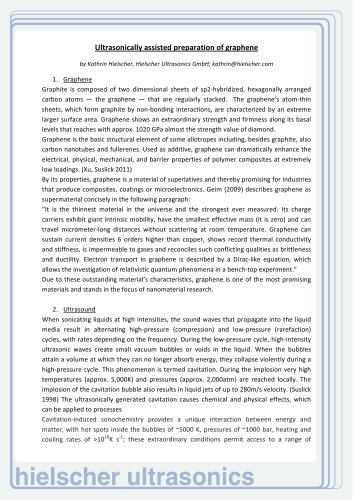
Catalog excerpts
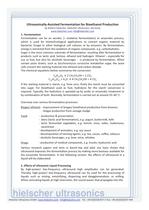
Ultrasonically-Assisted Fermentation for Bioethanol Production by Kathrin Hielscher, Hielscher Ultrasonics, Germany www.hielscher.com; info@hielscher.com 1. Fermentation Fermentation can be an aerobic (= oxidative fermentation) or anaerobic process, which is used for biotechnological applications to convert organic material by bacterial, fungal or other biological cell cultures or by enzymes. By fermentation, energy is extracted from the oxidation of organic compounds, e.g. carbohydrates. Sugar is the most common substrate of fermentation, resulting after fermentation in products such as lactic acid, lactose, ethanol and hydrogen. Ethanol – especially for use as fuel, but also for alcoholic beverages - is produced by fermentation. When certain yeast strains, such as Saccharomyces cerevisiae metabolize sugar, the yeast cells convert the starting material into ethanol and carbon dioxide. The chemical equations below summarize the conversion: C6H12O6 → 2 CH3CH2OH + 2 CO2 C12H22O11 + H2O → 4 CH3CH2OH + 4 CO2 If the starting material is starch, e.g. from corn, firstly the starch must be converted into sugar. For bioethanol used as fuel, hydrolysis for the starch conversion is required. Typically, the hydrolysis is speeded up by acidic or enzymatic treatment or by combination of both. Normally, fermentation is carried out at around 35–40 °C. Overview over various fermentation processes: Biogas/ ethanol: - improvement of biogas/ bioethanol production from biomass - biogas production from sewage sludge Food: - production & preservation - dairy (lactic acid fermentation), e.g. yogurt, buttermilk, kefir - lactic fermented vegetables, e.g. kimchi, miso, natto, tsukemono, sauerkraut - development of aromatics, e.g. soy sauce - decomposition of tanning agents, e.g. tea, cocoa, coffee, tobacco - alcoholic beverages, e.g. beer, wine, whiskey - production of medical compounds, e.g. insulin, hyaluronic acid Various research papers and tests in bench-top and pilot size have shown that ultrasound improves the fermentation process by making more biomass available for the enzymatic fermentation. In the following section, the effects of ultrasound in a liquid will be elaborated. 2. Effects of Ultrasonic Liquid Processing By high-power/ low-frequency ultrasound high amplitudes can be generated. Thereby, high-power/ low-frequency ultrasound can be used for the processing of liquids such as mixing, emulsifying, dispersing and deagglomeration, or milling. When sonicating liquids at high intensities, the sound waves that propagate into the Hielscher Ultrasonics GmbH www.hielscher.com; info@hielscher.com Tel.: +49 (0)3328/437-3 Fax: +49 (0)3328/437-444
Open the catalog to page 1
liquid media result in alternating high-pressure (compression) and low-pressure (rarefaction) cycles, with rates depending on the frequency. During the lowpressure cycle, high-intensity ultrasonic waves create small vacuum bubbles or voids in the liquid. When the bubbles attain a volume at which they can no longer absorb energy, they collapse violently during a high pressure cycle. This phenomenon is termed cavitation. Cavitation, that is "the formation, growth, and implosive collapse of bubbles in a liquid. Cavitational collapse produces intense local heating (~5000 K), high pressures...
Open the catalog to page 2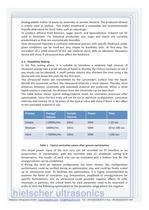
biodegradable matter of waste by anaerobic or aerobic bacteria. The produced ethanol is mainly used as biofuel. This makes bioethanol a renewable and environmentally friendly alternative for fossil fuels, such as natural gas. To produce ethanol from biomass, sugar, starch, and lignocellulosic material can be used as feedstock. For industrial production size, sugar and starch are currently predominant as they are economically favorable. How ultrasound improves a customer-individual process with specific feedstock under given conditions can be tried out very simple by feasibility tests. At...
Open the catalog to page 3
Picture 1 - ultrasonic lab device (100 watts) for feasibility tests effects are not observed. For the feasibility study small lab or bench-top units are recommended to limit the expenses for equipment and samples in such trials. Generally 100 to 1,000 Watts units serve the purposes of the feasibility study very well. (cf. Hielscher 2005) 3.2. Optimization The results achieved during the feasibility studies may show a quite high energy consumption regarding the small volume treated. But the purpose of the feasibility test is primarily to show the effects of ultrasound to the material. If in...
Open the catalog to page 4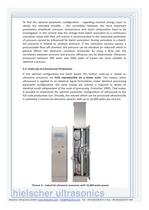
To find the optimal parameter configuration - regarding minimal energy input to obtain the intended benefits – the correlation between the most important parameters amplitude, pressure, temperature and liquid composition have to be investigated. In this second step the change from batch sonication to a continuous sonication setup with flow cell reactor is recommended as the important parameter of pressure cannot be influenced for batch sonication. During sonication in a batch, the pressure is limited to ambient pressure. If the sonication process passes a pressurizable flow cell chamber,...
Open the catalog to page 5
available and can be installed in clusters. Such clusters of ultrasonic processors can be installed parallel or in series. By the cluster-wise installation of high power ultrasonic processors, the total power is almost unlimited so that high volume streams can be processed without problem. Also if an adaption of the ultrasonic system is required, e.g. to adjust the parameters to a modified liquid formulation, this can be mostly done by changing sonotrode, booster or flow cell. The linear reproducibility and the adaptability of ultrasound makes this innovative technology to an efficient and...
Open the catalog to page 6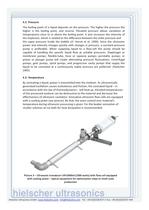
4.2. Pressure The boiling point of a liquid depends on the pressure. The higher the pressure the higher is the boiling point, and reverse. Elevated pressure allows cavitation at temperatures close to or above the boiling point. It also increases the intensity of the implosion, which is related to the difference between the static pressure and the vapor pressure inside the bubble (cf. Vercet et al. 1999). Since the ultrasonic power and intensity changes quickly with changes in pressure, a constant-pressure pump is preferable. When supplying liquid to a flow-cell the pump should be capable of...
Open the catalog to page 7All Hielscher catalogs and technical brochures
-
Ultrasonic Process Lab
1 Pages
-
Ultrasonic Wire Cleaning
4 Pages
-
Ultrasonic Applications
1 Pages
-
Hielscher Ultrasonic Sieves
2 Pages









